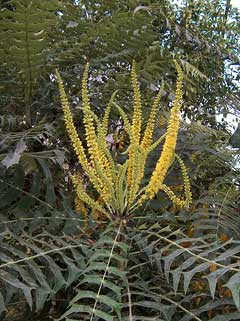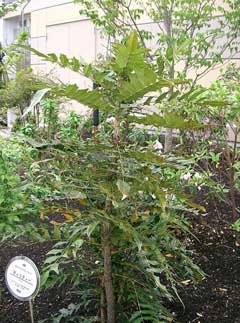 |
|
http://commons.wikimedia.org/wiki/User:Andel |
 |
| http://commons.wikimedia.org/wiki/User:KENPEI |
Translate this page:
Summary
Bloom Color: Yellow. Main Bloom Time: Early spring, Late spring, Mid spring, Mid winter. Form: Upright or erect.
Physical Characteristics

 Mahonia lomariifolia is an evergreen Shrub growing to 5 m (16ft) by 3 m (9ft) at a medium rate.
Mahonia lomariifolia is an evergreen Shrub growing to 5 m (16ft) by 3 m (9ft) at a medium rate.
See above for USDA hardiness. It is hardy to UK zone 7 and is not frost tender. It is in leaf all year, in flower from January to March, and the seeds ripen from May to June. The species is hermaphrodite (has both male and female organs) and is pollinated by Insects.
Suitable for: light (sandy), medium (loamy) and heavy (clay) soils. Suitable pH: mildly acid, neutral and basic (mildly alkaline) soils. It can grow in semi-shade (light woodland) or no shade. It prefers moist soil.
UK Hardiness Map
US Hardiness Map
Synonyms
Plant Habitats
Woodland Garden Sunny Edge; Dappled Shade;
Edible Uses
Edible Parts: Fruit
Edible Uses:
Fruit - raw or cooked. The oval fruit is about 5 - 8mm long, it is quite juicy and has a nice acid flavour that children tend to love though many adults are less sure. The fruit is especially nice when added to muesli or porridge[K]. Unfortunately, there is often relatively little flesh and a lot of seeds, though plants often also produce seedless fruits[K]. Unlike many members of this species, the seedless fruits of this plant do not have a bitter flavour[K].
References More on Edible Uses
Medicinal Uses
Plants For A Future can not take any responsibility for any adverse effects from the use of plants. Always seek advice from a professional before using a plant medicinally.
Antibacterial Antitumor Dysentery Tonic
Berberine, universally present in rhizomes of Mahonia species, has marked antibacterial effects[218] and is used as a bitter tonic[213]. Since it is not appreciably absorbed by the body, it is used orally in the treatment of various enteric infections, especially bacterial dysentery[218]. It should not be used with Glycyrrhiza species (Liquorice) because this nullifies the effects of the berberine[218]. Berberine has also shown antitumour activity[218]. The root and root bark are best harvested in the autumn[213].
References More on Medicinal Uses
The Bookshop: Edible Plant Books
Our Latest books on Perennial Plants For Food Forests and Permaculture Gardens in paperback or digital formats.

Edible Tropical Plants
Food Forest Plants for Hotter Conditions: 250+ Plants For Tropical Food Forests & Permaculture Gardens.
More

Edible Temperate Plants
Plants for Your Food Forest: 500 Plants for Temperate Food Forests & Permaculture Gardens.
More

More Books
PFAF have eight books available in paperback and digital formats. Browse the shop for more information.
Shop Now
Other Uses
References More on Other Uses
Cultivation details
Landscape Uses:Border, Foundation, Massing, Specimen, Woodland garden. Succeeds in any good garden soil. Grows well in heavy clay soils. Dislikes windy positions. Prefers a shady sheltered position, growing well in woodland according to one report whilst another says that it requires a warm sunny sheltered position. This species tolerates temperatures down to about -10°c when it is fully dormant[184], but plants can be badly damaged by cold drying winds[184] and are not fully hardy in the colder parts of Britain. The young growth in spring can be damaged by late frosts. The flowers are fragrant[245]. There is some confusion over the flowering and fruiting times of this species, I have seen some plants flowering in mid to late spring, whilst others have flowered in the winter and ripen their fruit in late spring to early summer - more research needs to be carried out in order to check if more than one species is grown under this name[K]. Very tolerant of pruning, it can be cut right back into old wood if it has outgrown its welcome[182]. Hybridizes freely with other members of this genus. Resistant to honey fungus[88]. Special Features:
Not North American native, Fragrant flowers, Attractive flowers or blooms.
References Carbon Farming Information and Carbon Sequestration Information
Temperature Converter
Type a value in the Celsius field to convert the value to Fahrenheit:
Fahrenheit:
The PFAF Bookshop
Plants For A Future have a number of books available in paperback and digital form. Book titles include Edible Plants, Edible Perennials, Edible Trees,Edible Shrubs, Woodland Gardening, and Temperate Food Forest Plants. Our new book is Food Forest Plants For Hotter Conditions (Tropical and Sub-Tropical).
Shop Now
Plant Propagation
Seed - best sown as soon as it is ripe in a greenhouse[78]. It usually germinates in the spring[K]. 'Green' seed (harvested when the embryo has fully developed but before the seed case has dried) should be sown as soon as it is harvested and germinates within 6 weeks[K]. Stored seed should be sown as soon as possible in late winter or spring. 3 weeks cold stratification will improve its germination, which should take place in 3 - 6 months at 10°c. Prick out the seedlings when they are large enough to handle and grow them on in the greenhouse for at least their first winter. Plant them out in late spring or early summer and consider giving them some protection from the cold for their next winter. Division of suckers in spring[78]. Whilst they can be placed direct into their permanent positions, better results are achieved if they are potted up and placed in a frame until established[11]. Leaf cuttings in the autumn.
Other Names
If available other names are mentioned here
Native Plant Search
Search over 900 plants ideal for food forests and permaculture gardens. Filter to search native plants to your area. The plants selected are the plants in our book 'Plants For Your Food Forest: 500 Plants for Temperate Food Forests and Permaculture Gardens, as well as plants chosen for our forthcoming related books for Tropical/Hot Wet Climates and Mediterranean/Hot Dry Climates. Native Plant Search
Found In
Countries where the plant has been found are listed here if the information is available
Asia, Australia, China*, Indochina, Myanmar*, SE Asia, Taiwan, Tasmania,
Weed Potential
Right plant wrong place. We are currently updating this section.
Please note that a plant may be invasive in one area but may not in your area so it’s worth checking.
Conservation Status
IUCN Red List of Threatened Plants Status :

| Related Plants
|
| Latin Name | Common Name | Habit | Height | Hardiness | Growth | Soil | Shade | Moisture | Edible | Medicinal | Other |
| Mahonia aquifolium | Oregon Grape, Hollyleaved barberry, Oregon Holly Grape, Oregon Holly | Shrub | 2.0 |
4-8
| F | LMH | FSN | DM | 3 | 3 | 3 |
| Mahonia bealei | Beale's barberry, Leatherleaf Mahonia | Shrub | 2.0 |
5-8
| S | LMH | FSN | M | 3 | 2 | 0 |
| Mahonia confusa | | Shrub | 1.5 |
6-9
| | LMH | FS | M | 3 | 2 | |
| Mahonia flavida | | Shrub | 2.0 |
7-10
| | LMH | FSN | M | 2 | 0 | |
| Mahonia fortunei | Fortune's Mahonia | Shrub | 2.0 |
7-9
| S | LMH | FSN | M | 3 | 2 | |
| Mahonia fremontii | Mahonia, Fremont's mahonia | Shrub | 2.5 |
7-10
| S | LMH | N | DM | 3 | 2 | 2 |
| Mahonia ganpinensis | | Shrub | 0.0 |
-
| | LMH | SN | M | 1 | 2 | |
| Mahonia gracilipes | | Shrub | 1.5 |
6-9
| | LMH | FS | M | 2 | 2 | |
| Mahonia gracilis | Mexican Barberry | Shrub | 1.5 |
7-10
| | LMH | N | DM | 2 | 0 | |
| Mahonia haematocarpa | Mexican Barberry, Red barberry | Shrub | 3.6 |
7-10
| | LMH | N | DM | 3 | 2 | 2 |
| Mahonia japonica | | Shrub | 2.0 |
5-9
| | LMH | FSN | M | 3 | 2 | |
| Mahonia napaulensis | | Shrub | 2.5 |
5-9
| | LMH | SN | M | 3 | 2 | 1 |
| Mahonia nervosa | Oregon Grape, Cascade barberry | Shrub | 0.6 |
5-9
| S | LMH | FSN | DM | 3 | 2 | 3 |
| Mahonia nevinii | Nevin's barberry | Shrub | 2.4 |
7-10
| | LMH | N | DM | 3 | 2 | 2 |
| Mahonia pinnata | California Barberry, Wavyleaf barberry, Island barberry, Creeping Holly Grape | Shrub | 1.8 |
7-8
| F | LMH | SN | M | 3 | 2 | 2 |
| Mahonia pumila | Dwarf Barberry | Shrub | 0.3 |
6-9
| S | LM | SN | DM | 3 | 2 | 3 |
| Mahonia repens | Creeping Oregon Grape, Creeping barberry, Grape Oregon | Shrub | 0.3 |
4-8
| S | LMH | SN | DM | 3 | 3 | 4 |
| Mahonia swaseyi | Texas Mahonia, Texas barberry | Shrub | 2.5 |
7-10
| | LMH | N | DM | 3 | 2 | |
| Mahonia trifoliolata | Mexican Barberry, Algerita | Shrub | 2.0 |
6-9
| | LMH | N | DM | 3 | 2 | 4 |
| Mahonia x media | | Shrub | 2.0 |
6-9
| | LMH | FSN | M | 3 | 2 | 0 |
|
Growth: S = slow M = medium F = fast. Soil: L = light (sandy) M = medium H = heavy (clay). pH: A = acid N = neutral B = basic (alkaline). Shade: F = full shade S = semi-shade N = no shade. Moisture: D = dry M = Moist We = wet Wa = water.

Expert comment
Author
Takeda.
Botanical References
11200
Links / References
For a list of references used on this page please go here
Readers comment